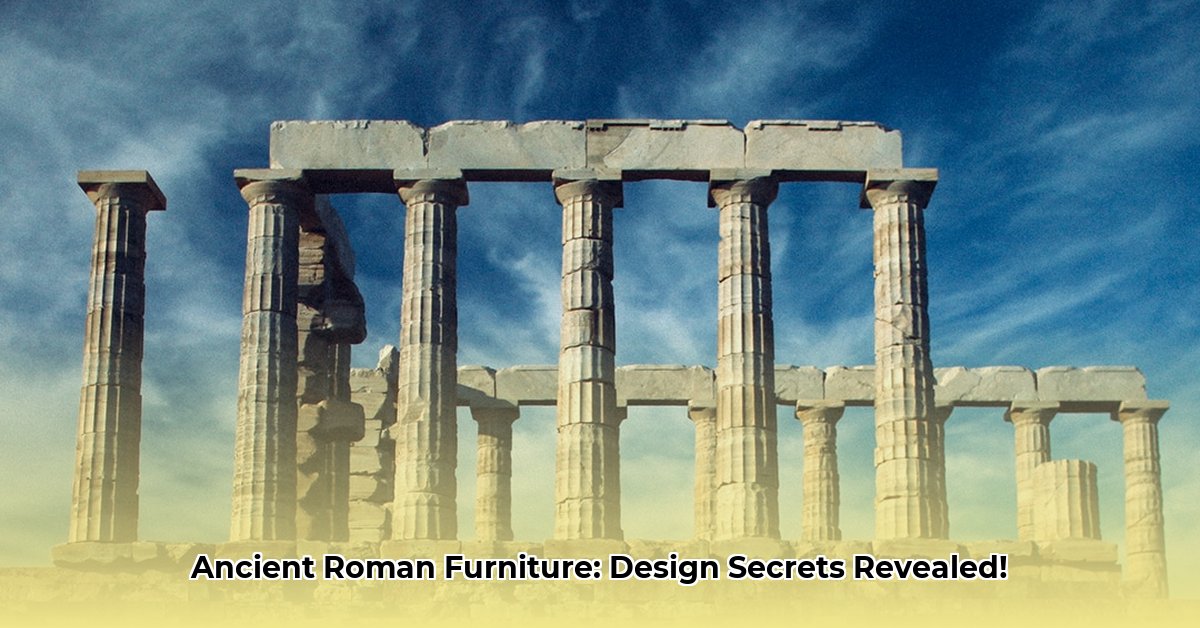Ever envisioned transforming your living space into a sanctuary of profound history and unparalleled sophistication? Journey back to ancient Rome, where design was not merely about aesthetic appeal but an intricate blend of functionality, social statement, and enduring comfort. Their remarkable ingenuity, often masterfully utilizing seemingly simple materials with an inherent appreciation for clean lines, offers invaluable lessons for contemporary interior design. This exploration will unveil how Roman design principles, particularly when contrasted with the resourceful simplicity and structural innovations of Sumerian craftsmanship, can inspire your modern projects, helping you cultivate unique, sophisticated, and deeply personal living environments. You might also find furniture in ancient Greece similarly inspiring.
Ancient Foundations: A Comparative Look at Roman and Sumerian Furnishings
Ancient Roman furniture, alongside the distinct pieces from ancient Sumer, provides invaluable insights into the daily lives, social hierarchies, and artistic expressions of their respective cultures. Separated by vast geography and millennia, both civilizations imbued their furniture with profound symbolic significance, reflecting their unique perspectives, available resources, and prevailing technologies.
The Sumerian civilization, flourishing in Mesopotamia (modern-day Iraq) from approximately 4000 BCE, primarily utilized readily available local materials. These included reeds, various types of palm wood, and clay, due to the inherent scarcity of high-quality timber in their region. Consequently, Sumerian furniture was inherently practical, durable, and resourceful. Common Sumerian pieces included beds, stools, chairs, and tables—often crafted from woven reeds or palm wood. While most people slept on the floor, beds were simple wooden frames, sometimes with tall headboards decorated with birds and flowers, and animal-paw shaped legs inlaid with precious metals for the elite. Wealthier Sumerians could afford more elaborate items, such as chairs luxuriously padded with felt, rushes, and leather upholstery, often further adorned with intricate inlays of bronze, copper, silver, or gold. Storage was paramount in Sumerian homes, leading to the widespread use of chests made from reed or intricately carved wood, alongside robust baskets and bins fashioned from sun-dried clay, palm wood, wicker, or reeds. Even humble reed mats were versatile, serving as floor coverings, building materials for homes, and even shrouds for skeletons.
In stark contrast, ancient Rome, drawing influence from Greek, Egyptian, and Etruscan traditions, embraced a wider array of materials and more complex, often luxurious, production methods. Romans favored durable stone (like marble), diverse types of wood (both local and exotic), and sturdy metals (such as bronze), prioritizing both elaborate aesthetics and robust construction. Affluent Roman homes were showcases of refined craftsmanship, featuring sophisticated tables (mensae), elegant reclining couches (lecti), and various forms of seating (sellae). The curule seat, an iconic and powerful symbol of political and military authority, epitomized Roman artistry through its distinctive folding X-shaped frame, frequently crafted from precious ivory or gleaming metal, signifying the status of high-ranking magistrates. Mensae, or tables, varied widely in design, ranging from small, single-legged side tables (monopodia) to grand, three-legged dining tables (delphicae) and rectangular abacuses, all of which could be adorned with intricate carvings or precious inlays. Some tables were made from cross-sections of highly prized citrus wood, with records indicating that figures like Cicero paid extraordinary sums, up to $20,000, for a single table, with one belonging to the Cethegi family reputedly valued at a staggering $60,000. Lecti, or couches, were central, multifunctional pieces, serving not only as beds for sleeping but also as primary dining spots and places to receive guests during the day. Wealthy Romans frequently embellished their furniture with lavish materials such as bronze, silver, gold, delicate ivory, and iridescent tortoise-shell, openly displaying their immense affluence and elevated social standing.
Dining customs profoundly shaped furniture design in both societies. Sumerians typically ate while seated on the floor, utilizing low tables for meals. Elite Sumerians further distinguished their dining experience by incorporating expensive metals into their tables and relying on various forms of baskets for food storage. Roman dining, particularly among the upper classes, revolved around the sophisticated practice of reclining on triclinia (three couches arranged around a low table), fostering easy conversation and relaxation during elaborate banquets. Roman dining tables often featured adjustable legs to suit various needs and were crafted from the most costly available materials.
Both societies also leveraged furniture as a clear indicator of social standing and economic prosperity. In Sumer, the quality, material, and embellishment of furniture directly correlated with an individual’s status, with wealthier citizens possessing significantly more elaborate pieces, while the majority used simple, perishable items. Similarly, in Rome, furniture served as a potent status symbol, especially the curule chair, which unmistakably conveyed authority during public functions. Luxurious chairs and beds within private homes likewise served as grand displays of the owner’s wealth and refined taste. These pieces were not merely functional objects; they were powerful statements of position, prosperity, and cultural identity.
| Feature | Ancient Roman Furniture | Sumerian Furniture |
|---|---|---|
| Primary Materials | Wood (oak, juniper, cedar, imported exotic woods), marble, bronze, iron, ivory, silver, gold, tortoise-shell, glass | Wood (palm wood, halub, kusabku, sulum meluhi, date palm, bamboo), reeds, felt, rushes, leather, clay, simple metals (bronze, copper, silver, gold for inlays) |
| Design Aesthetics | Ornate, decorative, highly symbolic, emphasis on form and status, clean lines even for elaborate pieces | Simple, highly functional, durable, often utilizing bundled or woven forms |
| Purpose & Utility | Functionality, significant status display, elaborate social interaction, versatile multi-use pieces | Primarily functional, basic comfort, efficient storage, essential household items |
| Key Furniture Pieces | Lectus (couches/beds), mensae (tables), sellae (chairs), curule chairs, arcae (chests), armaria (cabinets) | Stools, low tables, reed mats, beds (rare for most), storage chests, baskets, bins |
| Social Context | Directly reflected a complex social hierarchy and overt economic prosperity; often found in specialized rooms | Focused on utility, communal living arrangements, and basic needs; luxury reserved for a very small elite |
| Notable Feature | Integration of precious inlays and metalwork; emphasis on reclinable dining; portable status symbols | Ingenious use of perishable local materials; beds often featured animal-paw shaped legs; widespread use of mats |
Design Principles from the Eternal City: Timeless Aesthetics for Modern Homes
Roman furniture provides a captivating window into the daily life, societal values, and artistic sensibilities of an ancient civilization. The lecti (couches or beds) were central for lounging, dining, and sleeping; sellae (stools or chairs) provided varied seating; and mensae (tables) served for meals and display. Beyond functionality, pieces like the curule chair were potent symbols of political authority. These furnishings were statements of status, emphasizing elegance, structural integrity, and thoughtful utility over ostentatious ornamentation. Even in the most elite homes, where one might find intricately carved legs or delicate inlaid detailing, the overall Roman design remained remarkably streamlined and purpose-driven.
How can we integrate this enduring Roman elegance into our contemporary spaces? It involves a deep understanding of their core design principles:
- Symmetry and Balance: The Romans cherished symmetry, believing it brought a profound sense of harmony and order to their environments. Imagine a perfectly balanced living room where each element thoughtfully mirrors the other, creating visual equilibrium. You can recreate this by pairing furniture, art pieces, or architectural details in your designs, ensuring a sense of calm and proportion.
- Natural Materials: Romans had a distinct preference for honest, durable materials such as rich wood, luxurious marble, and sturdy bronze. Consider incorporating these elements, or their sustainable, ethically sourced alternatives like bamboo, reclaimed wood, or natural stone, into your designs. A minimalist coffee table with a polished marble top, echoing the grandeur of Roman mensae, could be a striking and elegant focal point.
- Geometric Shapes: From perfect circles to strong squares and precise rectangles, geometry played a fundamental role in Roman design and architecture, conveying stability and mathematical perfection. Think about adding furniture with bold, clear geometric forms—a cube-shaped side table, a rectangular console, or a circular pendant light. This provides a subtle yet impactful nod to the past with a sophisticated, modern twist.
- Elegant Simplicity: Roman design, while capable of immense grandeur, was rarely overly fussy or burdened with superfluous decoration. It was refined yet highly functional, prioritizing purpose alongside beauty. The key is to keep things elegantly simple: choose pieces that are both visually appealing and inherently practical, ensuring every item serves a purpose beyond mere ornamentation.
Natural light was also paramount in Roman homes, central to their architectural planning. Courtyards (peristylia) and atriums were strategically designed not only for ventilation but to maximize sunlight penetration into interior spaces. How can you achieve this illuminating effect in your contemporary space? Consider strategic window placement, the thoughtful use of reflective surfaces like mirrors or polished stone, and opting for minimal or sheer window coverings to allow natural light to flood in, creating an open and airy ambiance reminiscent of a Roman villa.
Materials: The Enduring Core of Roman Craftsmanship
The availability, inherent durability, and profound symbolic value of materials significantly shaped ancient Roman furniture design. These choices reflected both practical needs for robust construction and an unwavering desire to display wealth, status, and refined sophistication.
Consider the following key materials and their roles:
- Wood: Romans were adept carpenters, utilizing local woods such as sturdy oak, reliable beech, and resilient cork for more common or simpler pieces, valued for their availability and strength. However, exotic woods like cedar (from Lebanon), juniper, cypress, pine, elm (from the Balkans), ash, and especially rare ebony (from Kush and Punt), along with highly prized citrus wood, served as potent status symbols within elite households. These imported woods were often used for intricate inlays, veneers, or the construction of monumental pieces, demonstrating global trade connections.
- Marble: As Roman quarries expanded and techniques advanced, marble became widely used for tabletops, decorative elements, and even structural components. Its inherent beauty, cool touch, and remarkable durability made it a favored choice for luxury items, showcasing both the owner’s wealth and a refined aesthetic.
- Bronze & Iron: Bronze, valued for its robust durability, its ability to be cast into intricate forms, and its appealing metallic luster, frequently appeared as structural supports, decorative accents (like animal-headed finials or lion’s paw feet), and as embellishment on other furniture pieces. By 2000 BCE, bronze tools were common, facilitating intricate craftsmanship. Iron, introduced later, proved even more suited for furniture creation due to its superior strength and workability, particularly for components like sofa legs depicting powerful lions or women.
- Ivory & Silver: These were the absolute epitome of luxury materials, meticulously crafted and exclusively reserved for the wealthiest citizens. They were used to embellish the most prized possessions, such as chairs, beds, and chests, signaling immense affluence and unparalleled prestige. Tortoise-shell was also a highly valued inlay material.
- Textiles & Upholstery: While often perishable, evidence suggests rich textiles, leather, felt, rushes, wool, and even swan’s down were used for mattresses, cushions, and coverings on beds, chairs, and couches. Wealthy Romans furnished their couches and bed frames with elaborate tapestries, adding comfort and opulent visual appeal.
Archaeological discoveries continually shed new light on Roman material use. For instance, recent excavations in London unearthed a 2,000-year-old Roman funerary bed made of oak, meticulously crafted with carved feet and joints secured by small wooden pegs, providing a rare intact example of Roman woodworking. Similarly, the discovery of a first-century BCE bronze “mermaid bed” in northern Greece, though plainer in appearance, showcased intricate bronze work depicting mermaids and a bird with a snake, linking furniture to mythology. Even surprising finds like burnt beds at Pompeii reveal details about construction and materials, often made of fine, rare woods.
Bringing Ancient Grandeur Home: Modern Interpretations for Contemporary Living
Modern living, particularly in urban environments, presents its own set of challenges, most notably space constraints. These demands innovation in design: vertical storage solutions, multi-functional furniture, and designs scaled appropriately for contemporary homes. The key is to capture the enduring essence of Roman and Sumerian design—simplicity, functionality, natural materials, and an appreciation for craftsmanship—rather than attempting a precise, literal imitation. The goal is to create a dialogue between past and present, crafting spaces that are both elegantly stylish and profoundly timeless.
Here’s a refined approach to bringing these ancient vibes into your interior design projects:
| Feature | Roman Inspiration | Sumerian Influence |
|---|---|---|
| Material Choice | Embrace luxurious stone (marble, travertine), rich, sustainable hardwoods, and sophisticated metals (bronze, brushed brass). | Incorporate natural fibers (jute, linen, hemp), textured ceramics, and woven elements (baskets, reed screens). |
| Form & Structure | Prioritize geometric symmetry, clean lines, and architectural forms (arches, columns, balanced proportions). | Emphasize simple, robust, and inherently functional shapes; consider stacked or modular designs. |
| Application | Create elegant, uncluttered seating areas with classic lines; use statement tables as focal points. | Implement sustainable and clever storage solutions; introduce textured, earthy elements for warmth and practicality. |
| Color Palette | Utilize a foundation of neutrals (whites, creams, grays) accented with deep jewel tones (maroon, emerald, sapphire) and metallic touches. | Draw from an earthy palette of browns, ochres, deep blues, and greens, reflecting natural landscapes and materials. |
Modern Takes on Ancient Design Principles:
- Embrace Responsible Natural Materials: Prioritize sustainable materials like bamboo, responsibly sourced reclaimed wood, natural linen, or recycled stone. This honors the ancient world’s connection to nature while crafting visually appealing and eco-conscious furniture and decor. Consider the environmental impact and aesthetic longevity of your material choices.
- Prioritize Thoughtful Simplicity: Design furniture that focuses keenly on usefulness and refined elegance, echoing the functional yet sophisticated approach of the Romans and the enduring practicality of the Sumerians. This means stripping away unnecessary embellishments to reveal the inherent beauty of form and material.
- Insist on Visual Symmetry and Balance: Create spaces with symmetrical features, whether through furniture arrangement, architectural elements, or decorative accents. This principle, deeply rooted in Roman architecture, inherently brings visual order, harmony, and a timeless sense of calm to a room.
- Champion Versatility and Multifunctionality: Develop furniture pieces that can serve multiple purposes, capturing the efficient design ideas prevalent in the ancient world where every item often had several uses. A modern daybed, for instance, could seamlessly transition from a comfortable sofa to a guest bed or a lounge area, maximizing utility in smaller spaces.
For those eager to infuse their space with even more Roman or Sumerian flair, consider these actionable DIY elements that foster a connection to ancient craftsmanship:
- Creating Roman-inspired stencils for furniture decoration: Use classic geometric patterns, intricate meanders, or subtle Roman motifs like laurel wreaths or acanthus leaves to add an authentic, historical touch to cabinet doors, tabletops, or accent walls.
- Building a small Roman-style footstool: This relatively simple woodworking project, often using natural wood or reclaimed timber, can introduce a functional and decorative element that harks back to ancient Roman practicality and comfort. Consider a folding X-frame design for portability.
- Repurposing materials to create a Roman or Sumerian-inspired planter or storage vessel: Transform existing terracotta pots or create a stone-like finish on other containers to evoke the serene ambiance of Roman gardens or the utilitarian beauty of Sumerian storage jars. For a Sumerian touch, consider painting simple geometric patterns.
- Crafting woven reed or jute mats: Echo the Sumerian tradition of using natural fiber mats for floor coverings or wall hangings. This adds texture, warmth, and an earthy, handmade quality to your space.
| Aspect | Pros | Cons |
|---|---|---|
| Aesthetics | Offers timeless elegance, a sense of gravitas, and a deep connection to human history and cultural heritage. The clean lines and natural materials contribute to a sophisticated, enduring look that transcends fleeting trends. | Can appear austere or cold if not thoughtfully balanced with complementary textiles, softer textures, and personalized touches. Overdoing it can result in a museum-like feel rather than a comfortable living space. |
| Functionality | Emphasizes utility, practicality, and often incorporates space-saving or multi-functional designs, directly reflecting ancient resourcefulness and adaptive living. Many designs were inherently robust and built to last. | May lack the plush comfort and advanced conveniences (e.g., integrated technology, extensive storage compartments) found in some purely modern or hyper-specialized furniture designs. Authenticity may sometimes conflict with contemporary comfort expectations. |
| Materials | Encourages the use of natural, durable, and often sustainable materials, promoting longevity and responsible consumption. These materials develop a rich patina over time, adding character. | Can be expensive to source authentic, high-quality materials (e.g., solid marble, rare woods) or require specialized craftsmanship, increasing cost. Some traditional materials may require specific care or maintenance. |
| Adaptability | Easily integrated into various contemporary styles and spaces due to its clean lines, classic forms, and neutral palettes. It acts as a strong foundational style that can be layered with different decor elements. | Requires thoughtful planning and selection to avoid feeling out of place or resembling a mere replica. Achieving the right balance between ancient inspiration and modern functionality can be challenging without clear vision. |
| Cultural Depth | Provides a rich narrative and cultural story for the living space, inviting contemplation and conversation. It connects inhabitants to a legacy of human ingenuity and artistic achievement. | Risk of misinterpretation or oversimplification if the historical context is not understood or respected. Can be perceived as pretentious if not executed with genuine appreciation for the history. |
The Roman influence permeates modern architecture and design on a fundamental level, from the enduring strength and beauty of arches and columns to an unwavering emphasis on natural light, open courtyards, and an ergonomic approach to living spaces. Even surprising elements like ancient Roman “refrigerators”—sophisticated deep shafts filled with snow and ice, designed to preserve food like cheese, wine, and even oysters—demonstrate a commitment to practical innovation that resonates with contemporary concerns for efficiency and comfort. By understanding this rich historical tapestry and adapting its key elements, you can create a home that is both elegantly stylish and profoundly timeless. The ultimate goal is not to create a museum replica, but a living space that honors the spirit of Roman design—where ancient inspiration seamlessly meets modern comfort and individual expression.
Essential Roman Furniture Elements
| Furniture Piece | Description |
|---|---|
| Lectus | The versatile Roman couch or bed, a central, multi-functional piece used for relaxing, dining (especially on triclinia), sleeping, and receiving guests. Often highly decorated for the wealthy. |
| Sella | A general term for a stool or chair, varying significantly in design from simple, functional three-legged pieces for the general populace to highly ornate and symbolic seating for the elite, denoting status. |
| Mensa | The Roman table, used for dining, working, and displaying prized objects. Designs ranged from small, single-legged side tables (monopodia) to large, elaborately carved dining surfaces. |
| Curule Chair | A distinct, folding X-shaped chair, a powerful symbol of political and military power. Reserved specifically for magistrates and high-ranking officials due to its historical and ceremonial significance and often crafted from ivory or bronze. |
| Arca | A fundamental storage chest, typically made of wood and reinforced with iron, essential for securing clothing, jewelry, important documents, and other valuables within Roman homes. Often chained to the floor for security. |
| Armarium | A wooden cabinet, often divided into compartments, used for storage of various items, including books (in libraries) and ancestral wax masks (imagines) in the alae of a Roman house. |
| Lucerna | Ancient Roman oil lamps, typically small vessels holding olive oil with a wick. While providing |










